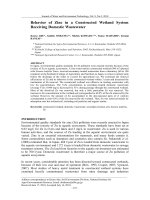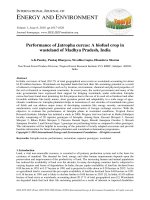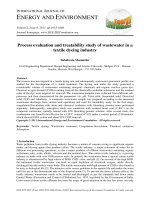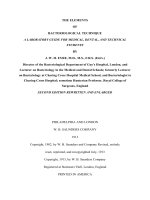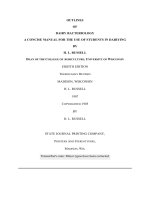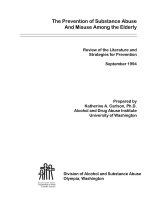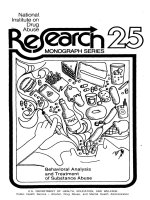cognitive therapy of substance abuse - a. beck, et. al., (guilford press, 1993)
Bạn đang xem bản rút gọn của tài liệu. Xem và tải ngay bản đầy đủ của tài liệu tại đây (17.04 MB, 371 trang )
COGNITIVE
THERAPY OF
SUBSTANCE
ABUSE
-•^
.^'^ySi:'yf^'^''->->*'
'r
^'i-'Mt
.#''a^K"'-M>'
•
M^
i€
• ^^.
M'^::.':^:
•^•rf-
AARON T. BECK
FRED D. WRIGHT
CORY F. NEWHAN
BRUCE S. LIESE
COGNITIVE THERAPY OF SUBSTANCE ABUSE Cognitive Therapy
of Substance Abuse
Aaron T. Beck, M.D.
Fred D. Wright, Ed.D.
Cory F. Newman, Ph.D.
Bruce S. Liese, Ph.D.
THE GUILFORD PRESS
New York London
©1993 The Guilford Press
A Division
of
Guilford
PubHcations,
Inc.
72 Spring
Street,
New
York,
NY 10012
www.guilford.com
All rights reserved
No part of this book may be reproduced, stored in a retrieval system,
or
transmitted,
in
any form or by any
means,
electronic,
mechanical,
photocopying, microfilming,
recording,
or
otherwise,
without written
permission from
the
Publisher.
Printed in the United States of America.
This book is printed on acid-free paper.
Last digit is print number: 9
Library of Congress Cataloging-in-Publication Data
Cognitive therapy of substance abuse / Aaron T. Beck . . [et al.].
p.
cm.
Includes bibliographical references and index.
ISBN
0-89862-115-1
(he.)
ISBN
1-57230-659-9
(pbk.)
1. Substance
Abuse—Treatment.
2. Cognitive
therapy.
I. Beck,
Aaron T.
[DNLM:
1.
Cognitive
therapy—methods.
2. Substance
Abuse—
therapy.
WM 270 C6765 1993]
RC564.C623 1993
616.86'0651—dc20
DNLM/DLC
for
Library
of
Congress 93-5208
CIP
To Phyllis, Gwen, Jane, and Ziana
s
L-#ubstance
abuse
is
widely recognized
as
a serious
social and legal problem.
In
fact, the use of illegal drugs may be
responsible for more than 25% of property crimes and 15% of violent
crimes.
Financial losses related to these crimes have been estimated
at $1.7 billion per
year.
Homicides are also strongly linked to drug
dealing.
Approximately 14% of homicides per year are causally related
to
drugs.
The costs for criminal justice activities directed against drug
trafficking on the federal level were approximately $2.5 billion in
1988,
compared to $1.76 billion spent in 1986.
There are also many health problems caused by these drugs.
Alcohol can damage almost every body organ, including the heart,
brain,
liver, and stomach. Illegal drugs such as cocaine can have a
serious effect on the neurological, cardiovascular, and respiratory
systems.
Cigarettes can cause
cancer,
heart
disease,
and
more.
The most
widely used and abused drug in the world is alcohol. In the United
States,
two-thirds of the population drink
alcohol.
About ten out of a
hundred people have problems with alcohol so serious that they can
be considered "alcoholic" or "alcohol-dependent."
(Interestingly,
this
10%
of Americans buys and drinks more than half of the alcoholic
beverages!)
At least 14 million Americans take
illegal
drugs every
month.
Dur-
ing "peak months" this number climbs to more than 25 million users.
Some experts have estimated that approximately 2.3% of Americans
over
12
years of age have a problem with
illegal
drugs serious enough
to warrant drug treatment.
To a large degree, we have tried to put a halt to drug abuse by
making drugs
illegal.
For example, heroin and cocaine are presently
illegal in the United
States.
Cigarette smoking is becoming increas-
ingly proscribed. At one time we tried to stop alcoholism by legal
Vll
via Preface
mechanisms (i.e., prohibition). Obviously, these methods will never
make substances completely unavailable.
Not
all
people who use drugs become addicted to them, although
many people have asked themselves, "Am I [or is someone
else]
an
alcoholic [or a substance abuser]?" The American Psychiatric Associ-
ation has defined the addictions very
specifically.
In
fact,
the official
term for an addiction is "substance dependence." There are some
specific signs of substance
dependence,
including
(1)
heavy use of the
substance, (2) continued use even though
it
may cause problems to
the person, (3) tolerance, and
(4)
withdrawal symptoms.
Cultural and historical factors are implicated in substance use and
abuse.
The patterns and consequences of drug use have been influ-
enced by historical developments, which have had positive and neg-
ative
effects.
Two centuries
ago,
the extraction of pure chemicals from
plant materials created more powerful medicinal
agents.
The inven-
tion of the hypodermic needle in the middle of the nineteenth cen-
tury was also a medical
boon,
which,
on the other
hand,
allowed drug
users to circumvent the body's natural biological controls consisting
of bitter taste and slow absorption through the digestive
tract.
Many
synthetic drugs developed in the twentieth century had medical appli-
cation but created further opportunities for abuse and addiction.
In
short,
any activity that affects the reward mechanisms of the brain
may lead to compulsive, self-defeating behavior.
Social,
environmental, and personality factors have affected sub-
stance use and abuse in ways that go far beyond the simple pharma-
cological properties of
these
agents.
Alcoholism,
for
example,
is
preva-
lent among certain ethnic groups and practically absent among others,
such as the Mormons, who require abstinence for group acceptance.
On the other
hand,
other
social
subgroups may condition group accep-
tance on using or drinking. The social milieu may influence using.
Soldiers used illegal drugs extensively in Vietnam
but,
for the most
part,
relinquished heavy drug use after returning
home.
Impoverished
environments have been shown in both animal experiments and
human studies to lead to
addiction.
As pointed out by
Peele,
the com-
mon denominator
is
the lack of other opportunities for satisfaction.
Finally, our clinical experiences have indicated that addicted
indi-
viduals have certain clusters of addictive attitudes that make them
abusers rather than users.
Successful treatment depends on
clinicians'
effectiveness in
deal-
ing with these addictive
potentials.
And what form
will
this care take?
As pointed out by Marc
Galanter,
president of the American Academy
of Psychiatrists in Alcoholism and
Addiction,
the long-term efficacy
of new pharmacological treatments is open to question. "Tricyclics,
Preface
ix
dopaminergic agents, and carbamazapine for cocaine abusers have yet
to be substantiated as a vehicle for continuing care. For opiates,
naltrexone and buprenorphine offer only a modest niche in the do-
main that was traditionally occupied by methadone maintenance.
Intervention in GABAergic transmission may hold promise for
alco-
hoHsm,
but that promise is far from clinical application" (Galanter,
1993,
pp.
1-2).
We have written this book in response to the ever-growing need
to formulate and test cost-effective treatments for substance abuse
dis-
orders,
problems that seem to be multiplying in the population in
spite of society's best efforts at international interdiction and domes-
tic control and education. We believe that cognitive therapy, a
well-
documented and demonstrably efficacious treatment model, can be
a major boon to meeting this pressing need.
At one
time,
"drug abuse rehabilitation counseling" was regarded
as a specialty area in the field of
psychotherapy—now
it is apparent
that almost
all
who engage in clinical practice will encounter patients
who use and abuse drugs. Therefore, it would be desirable for all
mental health professionals to receive some sort of routine training
and education in the social and psychological phenomena that com-
prise the addiction disorders. Our volume is intended to provide a
thorough, detailed set of methods that can be of immediate use to
therapists and
counselors—regardless
of the amount of experience they
might have had with cognitive
therapy,
or in the field of addictions.
Toward this end, we have strived to make our model and our proce-
dures as specific and complete as
possible.
We certainly recommend
that those who read this book also read the many valuable sources
we have cited in the
text.
Nevertheless,
our intention in writing Cog-
nitive Therapy of Substance Abuse has been to provide a convenient,
centralized source that is comprehensive, teachable, and testable.
Although advances in the field have been made in the form of
pharmacological interventions
(e.g.,
antabuse, methadone, and
nal-
trexone),
12-step
support groups
(e.g
Alcoholics Anonymous, Nar-
cotics Anonymous, and Cocaine
Anonymous),
and social-learning
models and programs (relapse
prevention,
rational
recovery,
etc.),
each
of these approaches has posed problems that limit
its
respective poten-
tial efficacy. For example, pharmacological interventions have
pro-
duced promising short-term data but are fraught with compliance and
long-term maintenance
difficulties^atients
may not take their chem-
ical agonists and
antagonists,
and they are prone to relapse when the
medications are discontinued. Twelve-step programs provide valuable
social support and consistent guidance principles for individuals who
voluntarily join and faithfully attend the program
meetings,
but can-
X Preface
not address the needs of those who will not enter the programs or
who drop
out.
Social-learning approaches provide sophisticated models
of substance abuse and relapse, and hold promise to produce and
accumulate empirical
data,
but thus
far
the resultant treatments (with
very few exceptions) have been less well described than the theories
that gave rise to them.
Although the cognitive approach that we have explicated
is
most
closely related to the social-learning theories of substance abuse, we
want to emphasize that we find value in all of the aforementioned
treatment
modalities.
Cognitive therapy
is
not in "opposition" to 12-
step or psychobiological models of substance
abuse.
We have found
that these alternative treatment systems may be complementary to our
procedures.
Many of the substance abuse patients that we treat at the
Center for Cognitive Therapy concurrently attend Narcotics Anony-
mous and similar 12-step groups. Other patients take the full spec-
trum of pharmacologic agents, from antidepressants to antabuse,
under strict medical guidance. The individualized conceptualization
of
patients'
belief
systems and the long-term coping
skills
(to deal with
everyday life concerns, as well as to manage cravings and urges
spe-
cific
to drug
use)
that cognitive therapy provides for patients can mesh
well with medication and 12-step meetings. The main variable that
seems to influence whether or not patients avail themselves of
all
of
these treatment opportunities (once they have been presented to the
patients in a feasible manner)
is
not the practical compatibility of the
treatments,
but rather the attitudes of
the
treatment
providers]
At
present,
an earlier draft of
this
book
is
serving as a treatment
manual in a National Institute on Drug Abuse
collaborative,
multisite
study on the respective efficacy of cognitive therapy, supportive-
expressive
therapy,
and general drug counseling. Data obtained from
this project will help us to answer two important
questions:
(1)
Does
Cognitive Therapy of
Substance Abuse
succeed as a manual for the train-
ing of competent cognitive therapists for patients with addictions? and
(2) Do patients who receive the treatment outlined in the text make
demonstrable and lasting gains? In order to answer these questions,
therapists are provided with intensive supervision
(note:
the authors
of
this
text serve in that
role),
complete with competency and adher-
ence ratings on a regular
basis;
treatment is not confounded with
adjunct
medications,
urinalyses are routinely conducted, and a host
of measures
other
than drug monitoring per se are being administered
and evaluated (to examine changes in mood and global adaptational
functioning).
Drug abuse is a sociological problem as well as a psychological
issue.
Factors such as poverty and lack of adequate educational and
Preface
xi
vocational opportunities play a role in the epidemic. However, we
believe that it is harmful to assume that low socioeconomic status
patients cannot be treated as effectively as those of higher socioeco-
nomic
status.
While social change is desirable, individual change is
not necessarily dependent on
it.
We are optimistic that cognitive ther-
apy can serve as an important individual-focused treatment in today's
society, and that the data will support
this.
Acknowledgments
w w e would like to offer our thanks to our highly
esteemed colleagues in the field of substance abuse treatment and
research,
Drs.
Dan
Baker,
Lino
Covi,
Tom
Horvath,
Jerome
Piatt,
Hal
Urschel,
David
Wilson,
and Emmett
Velten,
for their extremely help-
ful insights and suggestions on earlier versions of this manuscript.
Special thanks are due Dr. Kevin Kuehlwein, an important member
of our own cognitive therapy team in
Philadelphia,
for his thorough
evaluations and editorial work on many of the chapters in this book.
The input of
all
of the above has been invaluable during the course
of this
project.
We would also
like
to offer our thanks and apprecia-
tion to Tina
Inforzato,
who did yeoman work in typing this volume,
and
its
many
revisions.
Without her
tireless
efforts,
this
volume would
still be "on the drawing board."
Xll
Contents
CHAPTER
CHAPTER
CHAPTER
CHAPTER
CHAPTER
CHAPTER
CHAPTER
CHAPTER
CHAPTER
CHAPTER
CHAPTER
CHAPTER
CHAPTER
CHAPTER
CHAPTER
CHAPTER
CHAPTER
Append
1
2
3
4
5
6
7
8
9
10
11
12
13
14
15
16
17
ixes
References
Index
Overview of Substance Abuse
Cognitive Model of Addiction
Theory and Therapy of Addiction
The Therapeutic Relationship and Its Problems
Formulation of the Case
Structure of the Therapy Session
Educating Patients in the Cognitive Model
Setting Goals
Techniques of Cognitive Therapy
Dealing with Craving/Urges
Focus on Beliefs
Managing General Life Problems
Crisis Intervention
Therapy of Depression in Addicted Individuals
Anger and Anxiety
Concomitant Personality Disorders
Relapse Prevention in the Cognitive Therapy
of Substance Abuse
1
22
42
54
80
97
112
121
135
157
169
187
211
226
242
268
292
311
331
347
xm
1
Overview of
Substance Abuse
T
Ah(
.he
fabric of America is profoundly affected by
problems of substance
abuse.
They are problems that directly affect
those millions of Americans who suffer from substance abuse and
indirectly touch the lives of millions more in the larger social and
vocational networks around them. One in every ten adults in this
country has a serious alcohol problem (Institute of Medicine
[lOM],
1987) and at least one in four is addicted to nicotine (Centers for
Disease Control
[CDC], 1991a).
Approximately 1 in 35 Americans over
the age of 12 abuses
illicit
drugs
(lOM,
1990a).
This level of substance
abuse has profound
social,
medical, and psychological ramifications
on both the individual and the larger
societal
levels.
The CDC
(1991b),
for
example,
estimate that approximately 434,000 people in
this
coun-
try die each year as a result of cigarette smoking, and many thou-
sands
also
die as a result of alcoholism
(lOM,
1987)
and/or
illicit
drug
abuse
(lOM,
1990a). It
must be emphasized, however, that substance
abuse spans many more areas and the
toll
taken is far greater than
these simple mortality figures convey.
In this introductory chapter we set the stage for the cognitive
therapy of substance abuse. We begin with an overview of psycho-v
active substances and substance
abuse,
we briefly review the history
of psychoactive substance
use,
we describe the most commonly used
and abused psychoactive
substances,
we discuss cognitive models for
understanding substance abuse and
relapse,
and we scan traditional
methods for treating substance abuse.
2 COGNITIVE THERAPY OF SUBSTANCE ABUSE
BACKGROUND: PSYCHOACTIVE
SUBSTANCES AND SUBSTANCE ABUSE
Psychoactive substances are chemicals that affect the
central nervous system, altering the user's thoughts, moods, and/or
behaviors.
The revised third edition of the Diagnostic and Statistical
Manual of Mental Disorders
(DSM-lIl-R;
American Psychiatric Associa-
tion
[APA],
1987) categorizes psychoactive substances into 10 classes:
alcohol;
amphetamines or similarly acting sympathomimetics; can-
nabis;
cocaine;
hallucinogens;
inhalants;
nicotine;
opioids;
phencycli-
dine (PCP) or similarly acting arylcyclohexylamines; and sedatives,
hypnotics,
or
anxiolytics.
Each of these substances has unique prop-
erties and
effects.
Some substances that are abused have low addic-
tive potential
(e.g.,
hallucinogens),
while others have high addictive
potential
(e.g.,
crack
cocaine).
Some are typically smoked
(e.g.,
nico-
tine,
cannabis, and crack
cocaine);
others are ingested orally (e.g.,
hallucinogens and
sedatives);
while
still
others are taken intranasally
(e.g.,
powdered cocaine and
inhalants).
Some drugs lead the user to
feel "up" or energized
(e.g.,
amphetamines and
cocaine);
some cause
the user to
feel
"down" or relaxed (e.g., sedatives, hypnotics, and
anxiolytics);
while others
(e.g,
alcohol and nicotine) simultaneously
have both effects on the user.
DSM-III-R
distinguishes between substance abuse and dependence.
Abuse
is
defined as a maladaptive pattern of psychoactive substance
use while dependence (considered more serious than
abuse) is
defined
as "impaired control of use"
(i.e.,
physiological
addiction).
In this
volume,
we do not go to great lengths to emphasize this distinction.
Instead, we view any pattern of psychoactive substance use as prob-
lematic and requiring intervention
if it results
in adverse
social,
voca-
tional,
legal, medical, or interpersonal consequences, regardless of
whether the abuser experiences physiological tolerance or withdrawal.
Further, although we caution against an
all-or-none
view of addic-
tion and
recovery,
and although we acknowledge that some patients
seem to be more successful at engaging in controlled, moderate sub-
stance use than are
others,
we advocate a program of treatment that
strives for abstinence. In this manner we maximize the patients'
chances of maintaining an able and responsible
lifestyle,
reduce the
risk of
relapse,
and avoid giving patients the false impression that we
view a mere reduction in drug use as the optimal outcome.
History of Psychoactive Substance Use
Psychoactive substances have been used by most cul-
tures since prehistoric times (Westermeyer,
1991).
In
fact,
for centuries
Overview 3
psychoactive substances have served many individual and social func-
tions.
On an individual
level,
they have provided stimulation, relief
from adverse emotional states and uncomfortable physical symptoms,
and altered states of consciousness. On a social
level,
psychoactive
substances have facilitated religious
rituals,
ceremonies, and medical
functions.
Egyptian and Chinese opiate use was evident from the
earliest writings of these people (Westermeyer,
1991).
Marijuana was
referenced in India "as far back as the second millennium B.C."
(Brecher,
1972, p. 397).
Evidence of
Mayan,
Aztec,
and
Incan
medici-
nal and ritual drug use was evident from their statues and from draw-
ings on their buildings and pottery (Karan, Haller, & SchnoU, 1991;
Westermeyer,
1991).
Alcohol use goes back to paleolithic times (Good-
win,
1981) and Mesopotamian civilization gave one of the earliest
clinical descriptions of intoxication and hangover cures.
In modern times the World Health Organization (WHO) has been
concerned about drug and alcohol abuse problems on a worldwide
scale
(Grant,
1986).
As early as 1968 the WHO conducted an interna-
tional study of drug use in youth (Cameron,
1968),
and in a more
recent study (Smart, Murray, &
Arif,
1988) drug abuse and preven-
tion programs in 29 countries were
reviewed.
However, Smart and his
colleagues concluded from their review that "the seriousness of the
drug problem is well recognized in some countries but not in oth-
ers"
(p.
16).
Presently the WHO is addressing the issue of alcohol-
related problems by developing an international secondary preven-
tion protocol (Babor, Korner, Wilber, & Good,
1987).
Drug policies in the United States have been profoundly affected
by historical and sociocultural attitudes regarding psychoactive drugs
on a spectrum from less restrictive
(e.g.,
libertarian)
to more restrictive
(i.e.,
criminal).
Between the late 1700s and the late
1800s,
for example,
psychoactive
dnigs
(especially
narcotics)
were widely used in the United
States.
In
fact,
Musto
(1991)
reported
that
opium and cocaine were legally
available during
this
time from "the
local
dmggist."
A Consumers Union
report
(Brecher,
1972)
described
the
nineteenth century
as
"a dope fiend's
paradise"
due to such minimal
restrictions.
In the late 1800s and the
early
1900s,
medical conceptualizations of addiction began to develop,
however,
influenced to some extent by
Dr.
Benjamin Rush's
(1790)
ear-
lier
interest in the course of
addictions.
Magnus
Huss,
a Swedish physi-
cian,
first
used the term "alcoholism" in 1849
(lOM,
1990b).
At the same
time (late 1800s and early
1900s),
criminalization of drug use was m-
creasingly becoming
U.S.
policy.
In the 1960s and
1970s,
however,
atti-
tudes about drugs became
less
restrictive as
U.S.
sociopolitical
attitudes
generally became more liberal. Simultaneously, the disease model of
addictions was gaining widespread
acceptance,
partly due to the work
ofjellinek(1960).
4 COGNITIVE THERAPY OF SUBSTANCE ABUSE
Since the 1980s, the United States has again become less toler-
ant and more restrictive about
drugs.
At least two explanations can
account for this phenomenon: (1) The negative effects of drugs on
individuals,
families, and society have become more apparent with
increased use, and (2) sociopolitical attitudes in the United States
generally have become more
conservative.
At the same
time,
however,
there is increasing controversy about the disease model of addiction
("Current
Disease model," 1992; Fingarette, 1988; Peele & Brodsky,
with
Arnold,
1991)
and the criminalization of psychoactive substances
(R. L. Miller,
1991).
The Most Commonly Used Drugs
Alcohol
Alcohol
is
simultaneously a
chemical,
a
beverage,
and
a drug that "powerfully modifies the functioning of the nervous
sys-
tem" (Levin, 1990, p.
1).
Approximately 10% of Americans in the
United States have a serious drinking
problem;
60% are light to mod-
erate
drinkers;
and the remaining 30% of adults in the United States
do not consume any
alcohol.
Alcohol abuse, however, accounts for
approximately 81% of hospitalizations for substance abuse disorders
(lOM,
1987).
Remarkably, half the alcohol consumed in this country
is
consumed by the 10% who are heavy
drinkers.
A larger percentage
of men than women drink and a greater percentage of men than
women are heavy drinkers.
Alcohol initially acts as a general anesthetic, interfering with
subtle functions of
thought,
reason, and judgment (Miller &
Munoz,
1976).
As blood alcohol concentration (BAC)
increases,
however, the
effects become more intense until gross motor functioning is also
affected. At still higher BAC
levels,
sleep is induced, and ultimately
death may occur as a result of respiratory depression.
"Alcohol affects almost every organ system in the body either
directly or indirectly" (National Institute of Alcohol Abuse and Alco-
holism
[NIAAA],
1990, p.
107).
Thus with chronic
use,
alcohol can
cause serious multiple medical problems, including damage to the
liver,
pancreas,
gastrointestinal
tract,
cardiovascular
system,
immune
system, endocrine
system,
and nervous system. Alcohol has also been
strongly linked to the leading causes of accidental death in the United
States:
motor vehicle
accident,
falls,
and fire-related
injuries.
Further-
more,
approximately 30% of suicides and half of all homicides are
alcohol related
(lOM,
1987),
and estimates of annual deaths related
to alcohol use range between 69,000 and 200,000 per year
(lOM,
Overview 5
1987). In addition, a significant percentage of both violent and non-
violent crimes are committed under the influence of alcohol (cf.
McCord,
1992).
Chronic alcohol use can also have other profound
negative social consequences, including loss of
career,
friends, and
family. A great
deal
of physical and sexual abuse, for example, is
related to the intoxicated state of the offender
(Clayton,
1992;
Frances
&
Miller,
1991; Harstone & Hansen,
1984),
and general family
dys-
function often
is
associated with the alcoholism of one or more adult
members (Heath & Stanton,
1991).
Medical complications can even
reach insidiously into the next
generation,
in that maternal drinking
during pregnancy can cause fetal alcohol syndrome and other
seri-
ous birth defects. In
fact,
"prenatal alcohol exposure is one of the
leading known causes of mental retardation in the western world"
(NIAAA, 1990, p. 139).
Illicit Drugs
According to the
lOM
(1990a),
at least 14 million
persons consume
illicit
drugs monthly. During peak months this fig-
ures climbs to more than 25 million
users.
It
is
estimated that approxi-
mately 2.3% of the U.S. population over 12 years old has an illicit
drug problem sufficiently serious to warrant
treatment.
This statistic
is
substantially
higher,
however, for individuals who are incarcerated
(33%) or on parole or probation
(25%).
When these people are
included in the epidemiologic data, the estimate of illicit drug use
problems in the overall population increases to 2.7%.
Regarding the social costs of
illicit
drug
abuse,
it is
estimated that
more than 25% of property crimes and 15% of violent crimes are
related to illicit drug use by the criminal. Financial losses related to
these crimes have been estimated at $1.7 billion per
year.
Homicides
are also strongly linked to activities surrounding drug
dealing.
Approx-
imately 14% of homicides per year are causally related to
drugs.
The
costs for criminal justice activities directed against drug trafficking
on the federal level were approximately $2.5 billion in 1988, com-
pared to $1.76 billion spent in 1986. In the following sections we
present brief descriptions of the three most commonly used illicit
drugs:
marijuana, cocaine, and the opioids.
In 1972, a Consumers Union report identified marijuana as the
fourth most popular psychoactive drug in the world, after caffeine,
nicotine,
and alcohol (Brecher, 1972, p.
402).
Although
marijuanas
use has declined since
its
peak in
1979,
it still
remains the most widely
used illicit drug in Western society (APA, 1987; Weiss & Millman,
1991).
6 COGNITIVE THERAPY OF SUBSTANCE ABUSE
Marijuana is typically smoked, although it can also be ingested.
According to Weiss and Millman
(1991),
in spite of
its
generally sedat-
ing
effects,
marijuana's psychoactive effects in the user are quite
varied, "profoundly dependent upon the personality of the
user,
his
or her
expectation,
and the setting" (p. 160).
The health effects of marijuana have been widely debated and
remain quite controversial, probably due to the inconsistent effects
of the drug on the individual user and across different
users.
For some
time marijuana was considered relatively safe and nonaddictive
(Brecher,
1972).
Presently, however, it is associated with multiple
adverse physical and psychological
effects,
including labile affect and
depression,
amotivational
syndrome, impaired short-term memory,
and pulmonary disease (Weiss &
Millman,
1991).
According to DSM-
III-R,
marijuana dependence
is
characterized by heavy use of the drug
(e.g.,
daily)
with substantial impairment. Marijuana dependence also
puts one at risk for other psychological problems, as those who are
dependent on cannabis are also likely polysubstance abusers or
afflicted with other psychiatric disorders
(APA,
1987;
Weiss & Millman,
1991).
Cocaine
is
a major central nervous system stimulant that produces
euphoria,
alertness,
and a sense of
well-being.
It
may also lower
anxi-
ety and social inhibitions while increasing energy, self-esteem, and
sexuality.
Presently cocaine
is
among the most widely used
illicit
drugs.
In
fact,
cocaine use increased in 1991, "despite the Bush adminis-
tration's three-year war against drugs" (Mental Health
Report,
1992,
p.
5).
Clearly, for many people the positive short-term physiological
and psychological effects of cocaine maladaptively supersede the dan-
gers associated with acquiring and using the
drug.
According to Gawin
and EUinwood
(1988),
"The pursuit of
this
direct,
pharmacologically
based euphoria becomes so dominant that the user is apt to ignore
signs of mounting personal disaster" (p.
1174).
Cocaine is an alkaloid (as are caffeine and nicotine) which is
extracted from the coca
leaf.
In
its
pure form, raw coca leaves can be
chewed, although this practice
is
generally limited to native popula-
tions in the cocaine-producing countries (APA,
1987).
In the United
States,
cocaine is most commonly taken intrana-
sally
(i.e.,
snorted or
"tooted")
in the powder form of cocaine hydro-
chloride.
In this form, the user pours the powder on a hard surface
and then arranges
it
into "lines," one of which is snorted into each
nostril (Karan et
al.,
1991).
In powdered
form,
cocaine hydrochloride
can also be mixed with water and administered by intravenous injec-
tion.
This process is known as "shooting" or "mainlining" (Karan
et
al.,
1991).
Intravenous injection of cocaine results in intense sub-
jective and physiologic effects within 30 seconds
Oones,
1987).
Overview 7
Cocaine can also be smoked as a paste or in alkaloid form (i.e.,
"freebased").
In this form
it
also produces its effects within seconds.
Crack cocaine (named for the sound made by the cocaine as it is
freebased) is the currently popular form of freebase which
is
sold in
relatively inexpensive, prepackaged, and ready-to-use small doses
(Karan et
al.,
1991).
According to Karan et
al.
(1991),
low-cost crack,
approximately
$2-$
10
per
vial,
"has been widely available on the
streets in many American
cities
since 1985"
(p. 125),
making
it
easily
within the financial grasp of most teenagers and even the impover-
ished. Adding to this high availability is the especially troublesome
fact that crack cocaine produces an enormously intense and almost
instant high. Crack cocaine
is,
therefore, extremely addictive, lead-
ing to significant impairment in life functioning after only a few
weeks'
use on average (Gawin & EUinwood,
1988;
Smart,
1991),
much
faster than, for example, intranasal usage of
cocaine.
These charac-
teristics of crack cocaine make it especially prone to rapid increase
in the prevalence of
its
abuse.
Indeed, many observers suggest that cocaine use has already
reached epidemic levels
(Weinstein,
Gottheil,
&
Sterling,
1992).
In the
popular press, for example, a graphic biographical Reader's Digest
article describes cocaine as "the devil within" (Ola &
D'Aulaire,
1991).
This contrasts starkly with the glorification of cocaine in movies and
songs of the 1970s and early 1980s, when cocaine was seen as the
drug of choice of the affluent and powerful. In the scientific litera-
ture,
Gawin and EUinwood
(1988)
explain that "believing that the drug
was
safe,
millions of people tried
cocaine,
and cocaine abuse exploded"
(p. 1173).
These authors report that 15% of Americans have tried
cocaine,
and 3 million people had abused cocaine regularly by 1986,
resulting in "more than five times the number addicted to heroin"
(p. 1173).
Smart and
Adlaf (1990)
report also that an increasing num-
ber of cocaine abusers have sought treatment since the
1980s.
Cohen
(1991) attributes the "cocaine outbreak" to supply factors
(e.g.,
low
cost,
availability, and high
profitability),
external factors
(e.g.,
peer
pressure and media portrayals of drug
usage),
internal factors (e.g.,
hedonism, sociopathy, depression, and
life
stress),
and intrinsic drug
factors (e.g., "the pharmacologic
imperative").
Strikingly, cocaine
abuse occurs and persists in spite of dramatic medical problems that
are associated with its use: central nervous system damage, cardiac
arrest,
stroke,
respiratory
collapse,
severe hypertension, exacerbation
of chronic
diseases,
infection,
and psychiatric complications (Estroff,
1987).
Because cocaine abuse research has produced fewer pharma-
cological treatment alternatives than has research on some other illicit
drugs such as heroin (Alterman, O'Brien, & McLellan, 1991;
Covi,
Baker,
&
Hess,
1990; Stine,
1992),
and because of the extent and
8 COGNITIVE THERAPY OF SUBSTANCE ABUSE
severity of cocaine-related problems, we have placed proportionately
greater emphasis on cocaine and crack cocaine than on other drugs
in this treatment manual.
The
opioids,
including
heroin,
methadone, and
codeine,
are drugs
that pharmacologically resemble morphine. Drugs in this class
pro-
duce feelings of
euphoria,
relaxation,
and mood
elevation.
They also
have the potential for reducing
pain,
anxiety, aggression, and sexual
drives
(lOM,
1990a),
and are considered highly
addictive.
According
to Thomason and
Dilts
(1991):
Opioids have the capacity to commandeer all of an individual's
attention,
resources,
and
energy,
and to focus these exclusively on
obtaining
the
next dose
at
any
cost.
This vicious
cycle
repeats itself
every few
hours,
24 hours a
day,
365 days a
year,
for years
on end.
Comprehending the implications
of
opioid abuse shocks and stag-
gers the inquiring mind.
(p.
103)
Although the use of pharmacologic agonists such as methadone
(and antagonists such as naltrexone) traditionally has represented an
important component of treatment in the heroin
abuser,
methadone
itself
is
unfortunately subject to various forms of abuse
(e.g.,
black
market dealings or use with other
drugs).
Further,
many heroin abusers
find methadone to be inferior to the "real stuff," leading to high
noncompliance and dropout (Grabowski, Stitzer, & Henningfield,
1984) rates with these
programs.
Therefore,
we posit that pharmaco-
logic approaches (even for
heroin)
represent an incomplete treatment
strategy unless utilized in combination with psychosocial approaches
such as support groups and cognitive therapy.
Nicotine
Cigarette smoking is by far the single most prevent-
able cause of death in the United
States.
In
fact,
it
has been estimated
that 434,000 people died in 1988 due to cigarette smoking (CDC,
1991b).
This figure includes those who died of
cancer,
lung disease,
heart
disease,
house fires caused by careless smoking, and renal and
pancreatic
disease.
Approximately 49.4 million Americans (28.1%) are
regular cigarette smokers (CDC,
1991a),
despite the fact that cigarette
smoking
is
known to be a leading cause of morbidity and mortality
in this country.
Since the
mid-1970s,
however, the number of smokers has admit-
tedly decreased steadily. Historically, more men than women have
smoked; however, a higher proportion of men than women have also
quit
smoking.
It
has thus been projected that by the year
1995,
more
Overview 9
women than men will be smokers. Ironically, in spite of cigarettes'
historical and advertising linkage with
status,
wealth, and desirabil-
ity, it is
increasingly the case that the socially disadvantaged are over-
represented as smokers. The number of
minorities,
poor, and less
educated people who
smoke,
for
example,
has been disproportionately
higher than those who do not smoke, and this trend is expected to
continue
(Pierce,
Flore, & Novotny,
1989).
Nicotine is the psychopharmacologically addictive ingredient in
cigarettes.
As mentioned
earlier,
nicotine dependence is included in
DSM-III-R, along with the dependence on other psychoactive sub-
stances (alcohol, opiates, cocaine,
etc.).
Not surprisingly, we have
found the addictive process in cigarette smoking to be analogous to
the addictive process involved in the other psychoactive substances.
Therefore,
although nicotine addiction
is
not associated with the same
degree of
social,
vocational, and legal consequences as is addiction
to
illicit
drugs,
its medical hazards and the fact that early-life regular
smoking often leads to addiction to "harder" substances (Henning-
field,
Clayton, &
Pollin,
1990) make it an important area for mental
health
intervention.
Although
this
volume focuses relatively
little
on
methods specifically geared to smoking
cessation,
we believe that the
same principles of assessment and treatment
(e.g.,
coping with crav-
ings and modifying
beliefs)
that we outline in this book are highly
applicable to the patient addicted to nicotine.
Polysubstance Abuse
Individuals abusing one psychoactive substance are
likely to be simultaneously abusing another substance. In fact,
between 20% and 30% of alcoholics in the general public and approxi-
mately 80% in treatment programs are dependent on
at
least
one other
drug.
A prevalent combination is alcohol, marijuana, and cocaine
(N. S.
Miller, 1991, p. 198).
N S Miller (1991) explains that polysubstance abuse occurs tor
multiple
reasons.
For
example,
some drugs enhance the effects of
other
drugs,
while some drugs are used to avoid unwanted
side
effects
of
other
drugs.
Some drugs are used to treat drug withdrawal effects of
other drugs
and,
similarly,
some drugs are used as
substihites
for other
'^'"^The medical and psychological correlates of polysubstance abuse
are numerous (N.
S.
Miller,
1991).
They include problems associated
with each individual drug
(e.g.,
liver and heart disease associated
with
alcohol
abuse),
as well as those more commonly associated
with
multiple substances
(e.g.,
interaction-induced
overdose).
10
COGNITIVE THERAPY OF SUBSTANCE ABUSE
Dual Diagnosis: Substance Abuse
and Other Psychiatric Disorders
The coexistence of substance abuse with other psy-
chiatric disorders is also very common (e.g., Ananth et
al.,
1989;
Brown,
Ridgely, Pepper, Levine,
&
Ryglewicz, 1989; Bunt, Galanter,
Lifshutz,
& Castaneda, 1990; Davis, 1984; Hesselbrock, Meyer, &
Kenner,
1985;
Kranzler &
Liebowitz,
1988;
Nace,
Saxon,
&
Shore,
1986;
Nathan,
1988; Penick et
al.,
1984;
Regier et
al.,
1990;
Ross,
Glaser, &
Germanson, 1988; Schneier &
Siris,
1987).
In a survey of more than
20,000 Americans conducted by Regier et
al.
(1990)
it
was found that
individuals with psychiatric disorders were 2.7 times as likely to have
alcohol or other drug
problems,
compared to those without psychi-
atric
disorders.
In
fact,
37% of individuals with substance use disor-
ders had coexisting Axis I mental disorders.
From these data
it
appears that individuals with substance abuse
problems should benefit most from therapeutic interventions that
simultaneously address their other psychiatric disorders. Cognitive
therapy
is
ideally suited for these
individuals,
since
it
has been devel-
oped and tested on patients with depression, anxiety, and personal-
ity disorders (see Hollon &
Beck,
in
press,
for a most recent compre-
hensive
review).
In
fact,
an important component of cognitive therapy
involves the case conceptualization (Persons,
1989),
defined as the
evaluation and integration of historical
information,
psychiatric diag-
nosis,
cognitive
profile,
and other aspects of functioning (see Chap-
ter
5,
this volume, for a detailed description of the case conceptual-
ization).
When a coexisting psychiatric syndrome is found to exist
with a dmg or alcohol abuse
patient,
for
example,
the therapist focuses
simultaneously on substance abuse and the symptoms of the psychi-
atric syndrome as well as on any factors of interaction (see Chapters
14,
15,
and 16, this volume, for more on the treatment of patients
with dual
diagnoses).
RELAPSE PREVENTION
Substance abuse and dependence are characterized
both by remission and by
relapse.
In a classic review by
Hunt,
Barnett,
and Branch (1971) it was found that heroin, nicotine, and alcohol
were all associated with similar high rates and patterns of relapse
(p. 455;
see Figure
1.1).
These investigators found that two-thirds of
individuals treated had relapsed within 3 months. Many investigators
have speculated about the meaning of these
findings,
most inferring

